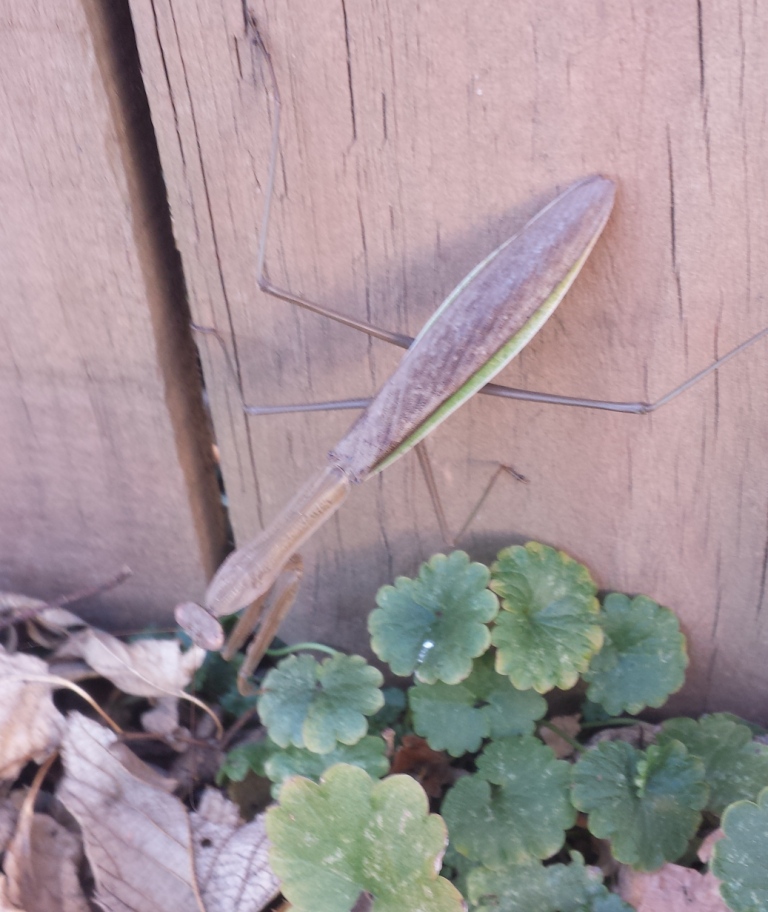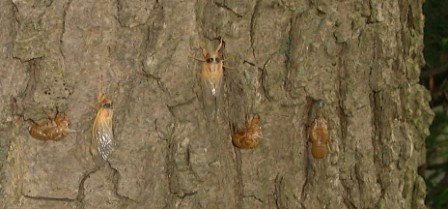Too numerous to list,
local insects range from fleas to cecropia moths, and
include an assortment of friendlies such as ladybird beetles and
mantises; and unfriendlies
such as ants, flies,
grasshoppers, mosquitoes, bees, hornets, and wasps.
Among the more notable specimens are cicadas,
dragonflies, fireflies, Japanese beetles, lady-bird
beetles, and praying mantises. The most visually
delightful, of course, are the butterflies: Resident
varieties include cabbage, fritillary, monarch, red
admiral, sulfurwing, black and tiger swallowtail.
Most are rather aloof, off doing their own thing; but
the red admirals are sociable, hanging out in small
groups and sometimes even landing on our heads or
shoulders.

A newly emerged adult Viceroy
perches on a rose to dry its wings before taking flight for the
first time.
(It let me get this close only because its wings were still too
heavy with moisture to allow it to fly.)

A praying mantis drops in to
inspect the ground cover by my neighbor's backyard fence, looking
for tasty snacks my lawnmower might have kicked up. Hi, chum!
If you find anything, you're welcome to it!
Worthy of special note,
if only because of their infrequent but overwhelming
visits, are the 17-year cicadas. They are rather
large as Ohio insects go, the adults being about 2.5
cm. long with a wingspan of nearly 6 cm.

Cicadas emerging on the trunk of a hackberry tree:
Over the next few hours, these light-colored juveniles will darken to
indigo-black, as their exoskeletons dry and harden.
Though
some people are terrified of them, cicadas do not bite
or sting. They do not attack humans (or any
animals, for that matter). However, they are
very poor navigators (both in the air and on the
ground), and sometimes run into people by
mistake. A sudden "CHERRT" next to
your ear announces one's arrival on your shoulder,
and you can be assured he's just as surprised by the
encounter as you are. A cicada's grip is firm, but not
painful; it can be gently picked or brushed off.
There is no question that cicadas are loud. If
picked up, one may emit a raspy hiss loud enough to startle its
handler into dropping it. En masse, their mating
chorus swells in slow, rhythmic waves from late morning until early
evening, and can cause temporary hearing loss in people exposed to
it for several hours.
Cicadas can be annoying
or frightening if you aren't used to them, but they
are interesting and impressive creatures. They
are beautiful in their own way, with their
indigo-black bodies, vermillion (or occasionally
white or turquoise) eyes, and golden wings.
Their frenetic activity begins in late spring or
early summer, and lasts for about a month. Then
the eggs are laid, the adults die, and the larvae
burrow deep into the soil, where they remain for
another 16 years and 10 months. (Though cicadas are not in
themselves in any way dangerous, I have heard of at
least one instance in which one landed on a driver's face,
startling him and causing an accident. Lesson: Keep your car
windows closed when you hear them.)